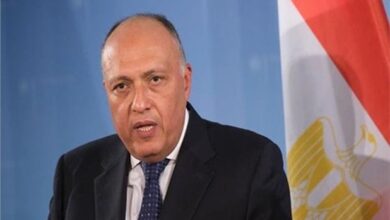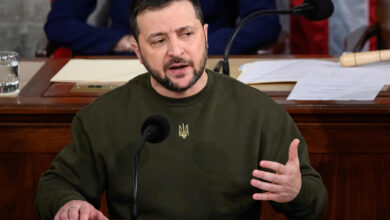
The chain-link fences, topped with coils of barbed wire, rise and fall like a serpent's back across the desert scrubland between Saudi Arabia and the jihadist threat across the Iraqi border.
A double-fence system and complementary hi-tech surveillance tools, officially opened in September, have become the front line of efforts to protect the kingdom from Islamic State (IS) group extremists who have seized vast areas of Iraq as well as Syria.
"As you know, the terrorists are the biggest threat," said border guards Major Mohammed al-Rashidi, a supervisor at Judaidat Arar command and control centre where officers monitor radar and cameras about 10 kilometres (six miles) from the frontier.
That threat became painfully clear in January when three border guards including a local commander were killed in nearby Suwayf in a battle with "terrorists".
The attack followed the launch in September of the kingdom's air strikes on IS targets in Syria as part of a US-led coalition.
The jihadists have claimed responsibility for widespread atrocities including the burning alive in a cage of a Jordanian fighter pilot.
Saudi Arabia's involvement in air strikes on IS targets has raised fears of retaliation by the group.
Authorities did not specifically blame IS for the Suwayf attack on the armed unit which protects the kingdom's land and sea frontiers.
However, the interior ministry has alleged three Saudis operating "in support of" IS shot and wounded a Danish national in a separate attack in Riyadh in November.
Authorities have also blamed IS-linked suspects for the November killing of seven members of the minority Shiite community in Eastern Province.
Border guards are taking no chances after the death of their regional commander General Odah al-Balawi and the other troopers.
– Shoot on sight –
"Nowadays, anybody trying to cross the border, we deal with them as terrorists," Rashidi said in his command centre, one of several along the northern frontier.
That means they will be shot on sight, an order that applies all along the more than 800-kilometre border.
Rashidi said they have not yet had to carry out the directive along his sector covering nearly a quarter of the frontier.
In a room resembling a small lecture hall, five officers sit at desks monitoring radar and camera feeds from the border while telephones bleep.
On one screen, a radar sweeps a green and yellow path, highlighting about 30 white dots, moving objects which could be suspicious.
An adjacent camera image, either infrared or daylight, helps the operator decide whether the objects are innocent or an "enemy" to be marked in red.
Then a message is relayed to the laptops of troopers at Rapid Response Stations in the field.
"When we have an incident we send six men, two cars," at least, Rashidi said. They are armed with Heckler & Koch G3 rifles and machineguns.
Rashidi's command centre and others already online have combined to create what officers call an "almost finished" northern network.
It replaces traditional patrolling on the ground to guard against smugglers and other infiltrators.
In November, the kingdom expanded a no-go zone 10-20 kilometres south of the border.
"It's very difficult" for anybody to cross the border now, Rashidi said.
The only people allowed into the restricted zone are border guards, other government employees, and foreign labourers working with them.
Nobody else really lives in the region of yellowed, barren earth.
The paved road leading north to Iraq through the Suwayf area is flanked by barbed wire fencing and blockaded.
It once brought travellers to a sprawling walled Saudi customs compound. That was the only official crossing point but it has been closed for more than two decades.
IS does not control territory in southernmost Iraq but it was from there that the four attackers, all Saudis, came in January.
Cameras spotted them but when border guards went to investigate they came under fire, security officers said.
The battle ended down a bumpy track that leads from the fence to a wide, bowl-like depression in the hard ground and thorny scrub.
Here, officers say, an attacker blew himself up, killing Balawi and his driver.
The weeks since have not erased the blood which has darkened the ground in a rough circle the size of a dinner plate. Spent cartridge cases and an unfired bullet lie in the nearby dirt.




